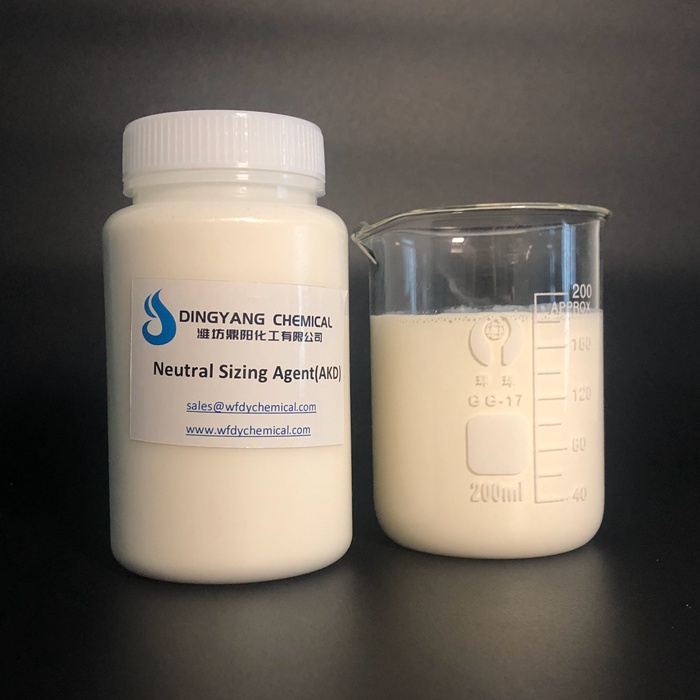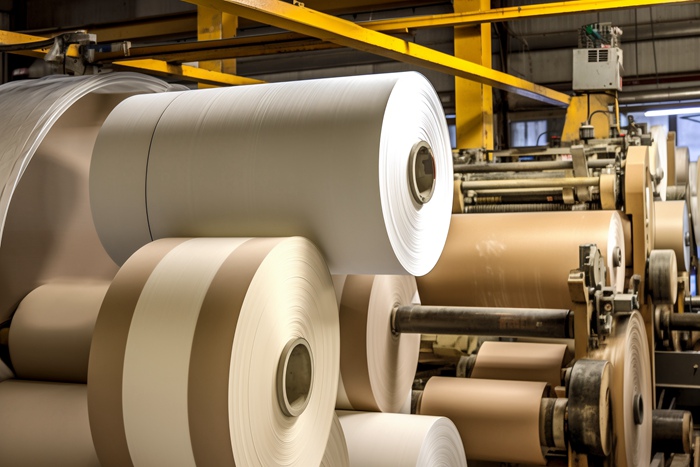AKD neutral sizing agent use, sizing process control and precautions
1. Storage and quality control of neutral sizing agent emulsion
Due to the activity of ketene dimer molecules, neutral sizing agent emulsion begins to undergo hydrolysis reaction as soon as it is produced, generating ketone compounds without sizing effect. In addition, due to the difference in emulsion stability, thickening will also occur during storage (viscosity increases to more than 50mpa.s), and in severe cases, a large number of bubbles and stratification will occur. If it is found that the viscosity of the neutral sizing agent emulsion increases seriously during storage; flocculation occurs; it falls in agglomerates when dropped into water or is poorly dispersed or floats upward; the foam of the emulsion is not easy to disappear when shaken up and down; the Zeta potential decreases or even becomes negative, then the emulsion of this neutral sizing agent cannot be used anymore.
The storage temperature of the emulsion should be 5-30℃, avoid exposure to sunlight, try to shorten the storage time of the emulsion, use fresh emulsion within the shelf life, and the goods should be first in first out.
The following conditions must be met before use:
(1) The appearance is delicate, the emulsion has no “hanging ring” phenomenon, and it can be evenly dispersed in water without flocculation.
(2) The viscosity should be normal. Taking 10% neutral sizing agent emulsion as an example, the viscosity should be stable below 20 mPa. below 30℃.
(3) The Zeta potential is about +15mV.
2. The amount of neutral sizing agent
When using neutral sizing agent for sizing, there is a characteristic in the amount, as shown in the figure: the sizing curve of neutral sizing agent has a minimum addition amount. If the amount is lower than this amount, there is almost no sizing effect. When the addition amount reaches a certain level, the sizing degree will jump. This amount is the minimum limit. In the future, as the amount increases, the sizing degree increases, but after reaching a certain amount, the increase in sizing degree becomes smaller.
For general cultural paper: 0.1~0.3% (absolute dry basis) can meet the requirements, and it should not be too high. When the sizing degree is not good, the internal reasons should be found out, and the dosage should not be increased blindly, otherwise it will be counterproductive.
Neutral sizing agent is a reactive sizing agent. The sizing agent takes effect slowly and requires a certain aging time (generally after 24 hours) to reach the final sizing degree. When testing the sizing degree after leaving the machine, the paper sample should be placed at 110℃ for a few minutes to accelerate the aging and then measured. To achieve the desired sizing effect, it is necessary to combine the actual production. First, add the upper limit of the absolute dry dosage of the neutral sizing agent (such as 0.25%), and then gradually reduce it until the minimum amount is reached. It can also be adjusted according to the amount of added paper.
3. Addition method
Neutral sizing agent emulsion can be diluted with water to a concentration of about 3-5%, and can be used after a little stirring. Because the neutral sizing agent is easy to hydrolyze, it is generally not suitable to exceed 8 hours after dilution. It can also be used directly without dilution.
Neutral sizing agent emulsion at higher concentration should be added using a diaphragm pump or gravity metering to avoid or reduce the negative impact of mechanical shear force on the stability of neutral sizing agent emulsion.
4. Control of pH value and total alkalinity of pulp on the screen
When the pH of the pulp in the front box is controlled at 7.5-8.5 and the total alkalinity is 150-250 mg/L, the sizing efficiency and aging rate of the neutral sizing agent can be improved. Note that the pH cannot be lower than this value, otherwise it will not only fail to achieve the sizing effect, but also affect other qualities of the paper.
5. Filler
Anionic chemicals, fillers with high specific surface area and oxidants are not conducive to the sizing of neutral sizing agents. In production, attention should be paid to selecting the type and amount of fillers. Under the premise of meeting the opacity and smoothness of the paper, GCC is more conducive to the sizing of neutral sizing agents and can relatively increase the amount of fillers (generally 15-20%).
Generally, 65-grade heavy calcium carbonate slurry is used as filler instead of talcum powder, because talcum powder has considerable adsorption capacity for neutral sizing agent. If talcum powder is used, the amount of neutral sizing agent added should be much larger when the same sizing degree is achieved. Calcium carbonate slurry is directly added to the mixing tank.
The addition of filler has a certain influence on the sizing degree. First, the presence of filler will reduce the contact between the neutral sizing agent particles and the fiber, that is, affect the retention; second, the filler has a certain adsorption effect on the neutral sizing agent. Therefore, if the amount of filler is too large, the sizing degree will be significantly affected at the same amount of neutral sizing agent. Generally, the amount of filler added is about 20%. At the same time, the addition point of the neutral sizing agent should generally be before the addition point of the filler to reduce the adsorption of the filler on the neutral sizing agent.
6. Retention aid
In order to ensure the retention rate of the neutral sizing agent, ensure the sizing degree of the paper, and the first-pass ash retention rate is above 30%, a qualified retention aid system should be selected. Using retention aids properly can improve the first-pass retention rate of the web and reduce the repeated circulation of neutral sizing agents in white water.
At present, domestic manufacturers mostly use high molecular cationic (or anionic) polyacrylamide (PAM) + cationic starch retention aids.
7. Fluorescent whitening agent
The amount of fluorescent whitening agent added is generally 0.1%. It can be added directly to the mixing tank. It should be noted that calcium carbonate is a good retention carrier for fluorescent whitening agents. Fluorescent whitening agents can be mixed with fillers and added together.
8. The location of adding various additives
The feeding position in the figure below is for reference only. Each company should adjust it according to the equipment conditions and the uniformity and strength requirements of the paper.
The addition position of neutral sizing agent, most domestic users add it after the mixing tank, that is, after adding calcium carbonate. Some foreign users add it before calcium carbonate. The reason is that calcium carbonate has a certain adsorption effect on neutral sizing agent. Adding it “before” can reduce this adsorption, thereby improving the utilization rate of neutral sizing agent.
Neutral sizing agent can be added to the pulp after cationic starch. If cationic starch is added to the pulp mixing tank in the production process, the neutral sizing agent is preferably added in the high-position box or a nearby position.
Cationic starch can also be added in two parts, 70% to the mixed pulp tank and 30% to the front box. Polyacrylamide should be added to the front box as much as possible. The position of its addition has a certain influence on the retention effect of the neutral sizing agent.
9. Control the temperature of the drying section and the moisture content of the finished paper
9.1 Control of the temperature of the drying section
The sizing effect is mainly reflected in the drying section of the paper machine. For multi-cylinder paper machines, especially the temperature of the first few drying cylinders should be higher (the minimum should not be lower than 100°C), which is conducive to the rapid melting and diffusion of the neutral sizing agent, making it more evenly distributed, reacting with the fiber faster, and arranging more orderly. At the same time, the moisture content of the finished paper out of the drying cylinder is also required to be relatively low (95-97%). Relatively low moisture content of the finished paper is conducive to achieving a higher sizing effect on the paper off the machine and reducing the aging time.
Higher drying temperature can accelerate the reaction rate of the retained neutral sizing agent with the fiber, and improve the sizing efficiency and aging rate of the neutral sizing agent. Therefore, it is very important to make the temperature of the drying cylinder reach above 95°C as soon as possible.
9.2 The influence of good or bad water filtration of the wire section
Because the neutral sizing agent uses calcium carbonate filler when neutral sizing, the amount of neutral sizing agent emulsion is small, and calcium carbonate has good water filtration, the wet paper layer is dehydrated too quickly in the pulping and screen area, and is formed too early, affecting the uniformity and two-sidedness of the finished paper. Therefore, it is necessary to control the forming point of the wet paper layer in the wire section and the water line of the vacuum net box, and the vacuum degree of the water absorption box should be adjusted to reduce the water filtration speed.
9.3 Control of the sticky roller phenomenon in the press section
Sometimes, the neutral sizing agent will stick to the press roller: adhesive sticky roller and adhesive sticky roller. The above two types of sticky press rolls can be solved by taking measures according to different reasons. For example, the sticky roll can reduce the moisture of the wet paper sheet out of the press roll, reduce the proportion of short fibers or the amount of filler, etc. The adhesive sticky roll should check whether the emulsion is deteriorated.
10. Reasonable use of PAE resin
For neutral sizing with wheat straw pulp, it is possible to consider adding PAE wet strength agent to enhance the sizing effect and improve the strength of paper. The addition method varies according to the raw materials and product requirements, generally 0.01-0.05% (solid content 12.5%), and the addition position can be in the mixing tank or added at the same time as the neutral sizing agent.
11. Reduce negative interference
Anionic starch in surface sizing, latex in coated paper, adhesives, etc. will interfere with the retention system. These factors should be fully considered and the amount of broken paper should be stably controlled. Additives composed of surfactants that increase the capillary penetration of fibers (such as defoamers, dispersants, softeners, detergents, etc.) should be avoided from being added to the pulp or the residue in the pulp should be reduced.
12. Other issues to be noted when applying neutral sizing agents
The neutral sizing agent solid is a waxy substance, which is easy to remain in the sizing system. During production, attention should be paid to regular cleaning of the system, otherwise the sediment will be brought to the paper and holes and other quality problems will appear. If the neutral sizing agent emulsion is added without dilution, a filter should be added to the feed port to filter out mechanical impurities. After sizing with a neutral sizing agent, the whiteness of the paper should be greatly improved. If the whiteness decreases, the influence of factors such as water quality and pH should be considered.



